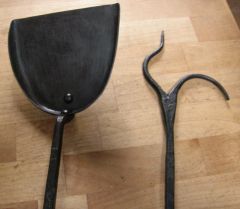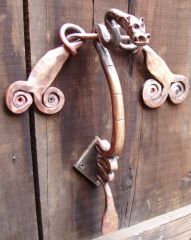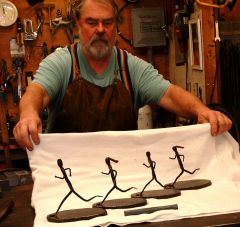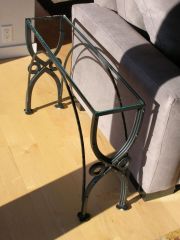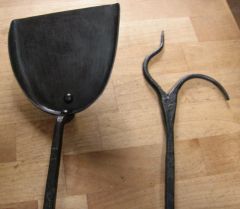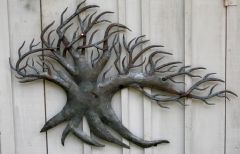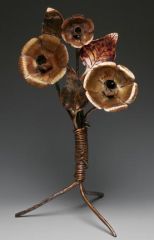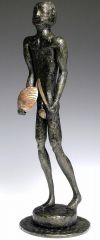
JJ
Members-
Posts
25 -
Joined
-
Last visited
Content Type
Profiles
Forums
Articles
Gallery
Downloads
Events
Everything posted by JJ
-
HEY! HOWDY! These pages are adding on faster than i can read 'em, so i just skipped up to page 6 to say howdy...i'm catchingh up.
-
-
-
IForgeIron Blueprints Copyright 2002 - 2007 IFORGEIRON, All rights reserved. BP0193 Diagonal Peen Hammer by James Joyce Talking about a blacksmith's hammer is about like talking of his dog, truck or wife. So, no matter what that style of hammer is called, Quarter peen, slash peen, Twisted face, Diagonal peen, Drawing hammer, or another name, let us be clear here, I am talking about MY hammer. Take what you like and leave the rest. This is the view I see when I go to a blacksmith's demonstration when he is using a standard cross peen hammer to fuller. He pulls his off hand in toward the center of his body, aligns the working hammer hand and goes at it. This is the view from the eye of the blacksmith doing the fullering. As you can see, as the standard cross peen strikes the work the blacksmith is essentially blind. His handle covers the view of where exactly the peen is striking. Several years ago a blacksmith named, I think, Jeffery Foote (?) thought this an intolerable intrusion on his otherwise fine workmanship. Jeffery told me he took a Swedish cross peen, heated it up, twisted the peen 45 degrees. He opened the world of blacksmithing to a new dimension of accuracy. And introduced the diagonal cross peen hammer to artist blacksmithing. When a right handed smith uses a left diagonal pein hammer, smith�s view of his fullering strike location is impeded with the diagonal cross peen hammer. When the right handed smith used a right diagonal pein, the smith�s view of his fullering strike location is no longer impeded with the right diagonal cross peen hammer. When the left handed smith used a left diagonal pein, the smith's view of his fullering strike location is no longer impeded with the left diagonal cross peen hammer. But when the left handed model of the diagonal cross peen is used by a right handed smith, it becomes a diagonal straight peen, again allowing an unimpeded view of work (his arm is now to the side) and producing greater accuracy and smoother work. This shows the body position of the smith fullering at the horn when using the diagonal cross peen. He has relaxed posture, with the natural hammer arm position at his side. Notice that from this position he can pin the off hand to his left side for easy control of the work piece. This shows the same smith forcing his arms into alignment in front of his body to fuller over the horn with a standard cross peen hammer. I hope this helps explain why many of us blacksmiths (like Rob Gunther and Bill Epps, to name just 2 you probably know) have switched over to diagonal peen hammers for better control of our work. A full set of smithing hammers should include a right and left as above, a cross peen, a straight peen and a round face spreading hammer, all of the peens should have at least a 1/2 inch rounded face so as not to make sharp dings in the material worked. View full article
-
-
wind blown cypress tree sculpture in progress......and copper leaves/ flowe
JJ posted a gallery image in Member Galleries
-
-
My name is Jim Joyce (JJ). I own Bear Path Forge a full-time metalsmith shop on the Northern Calif coast about 3 hrs north of San Francisco. Primarily I make forged architectural metal work and home accessories. I also work a line of art projects, preferring organic forgings and sculpture of humans, animals & birds. I forge mild steel, carbon steels, copper, silver, silicon bronze, naval brass and stainless steel, using both propane and coal/coke. For several years I have also taught blacksmithing classes: private classes, California Blacksmith Association classes, Mendocino Art Center classes and guest artist/instructor via the Santa Rosa Community College. Classes are usuallky weekends, throughout much of the year. We host weekend hammer in's about every 2 months. I teach all levels of blacksmithing from intro to advanced for both the hobbists and working smiths. Bear Path Forge and Gallery I am a member of the Artist Blacksmith Association of North America, the Appalachian Blacksmiths Association and the California Blacksmith Association. I apprenticed in metalworking in the 1960's.
-
IForgeIron Blueprints Copyright 2002 - 2011 IFORGEIRON, All rights reserved BP0313 Curtain Rod by James Joyce Make small shepherds crook tipped j hooks out of 1/4" sq by 3" long. Holding hook end with tongs, on nearside of anvil, use half blows to set down last 1/2" of sq end. Drill or punch for 11/64 hole and counter sink with 3/8" drill for installation screws. Heat one end of a 5/8" pipe or tube. Place hot end in a hinged fuller made for 1/2" diameter round swaging. Leave about 1 1/4" of rod sticking past the fuller, and swage down to 1/2" round. Fullered area should look like this. Exact location of fullering and length of pipe will depend on window frame width and location you want the hooks to go. Installed curtain rod and hanging hook ought to look like this. FYI: Choosing the size of the curtain rod tube: Remember that the bending strength (deflection / sag) is directly proportional to the diameter of the rod. In the bending strength / deflection formula, the OD is raised to the 4th power. Increasing the OD of the rod just a little will greatly reduce the sag in a given span. Increasing only the wall thickness of the tube (Sch 80 pipe vs Sch 40 pipe for example) mostly increases the weight of the rod and does very little to improve the resistance to sagging. View full article
-
IForgeIron Blueprints Copyright 2002 - 2011 IFORGEIRON, All rights reserved BP0311 Chisel Holder by James Joyce Two pics showing a 4" chisel, one of a large set of chisels and punches, along with a pair of tongs for gripping the square swaged area along the shaft, and the swage for making the square indent. Note that the swaged area of the tool (chisel) is well below the top of the tool. This keeps the special tongs from sliding up and off the tool when the tool is hit with a hammr. View full article
-
